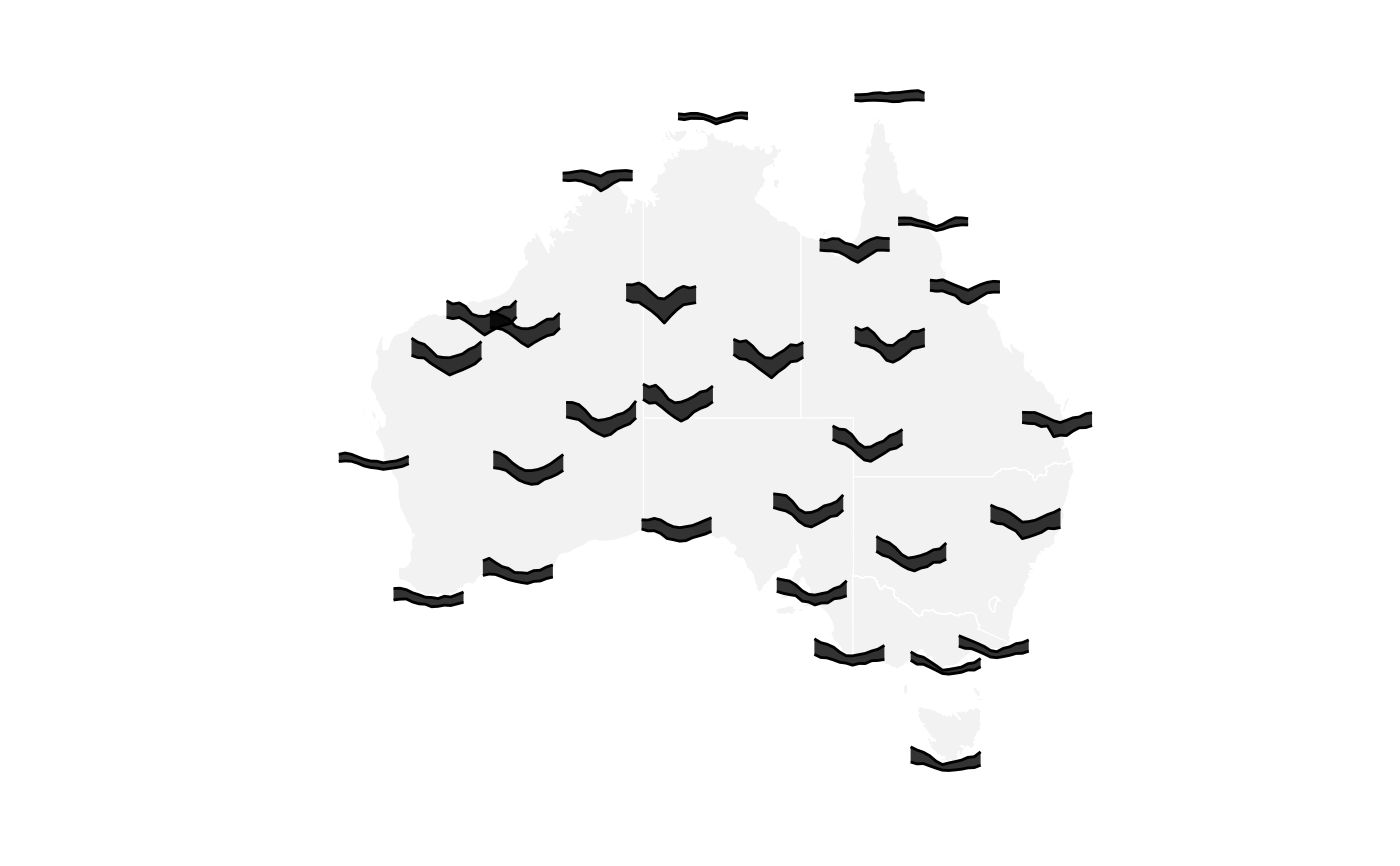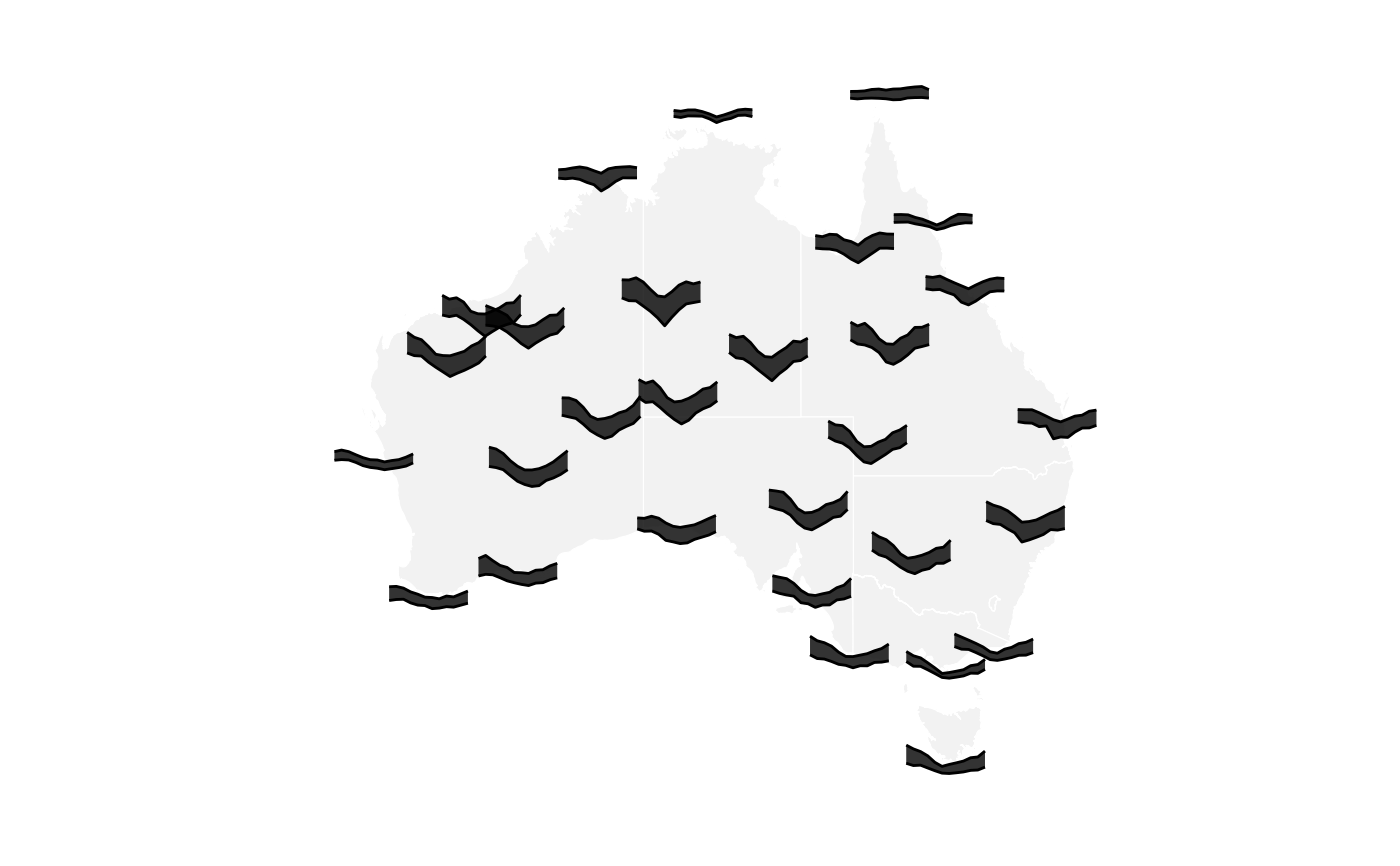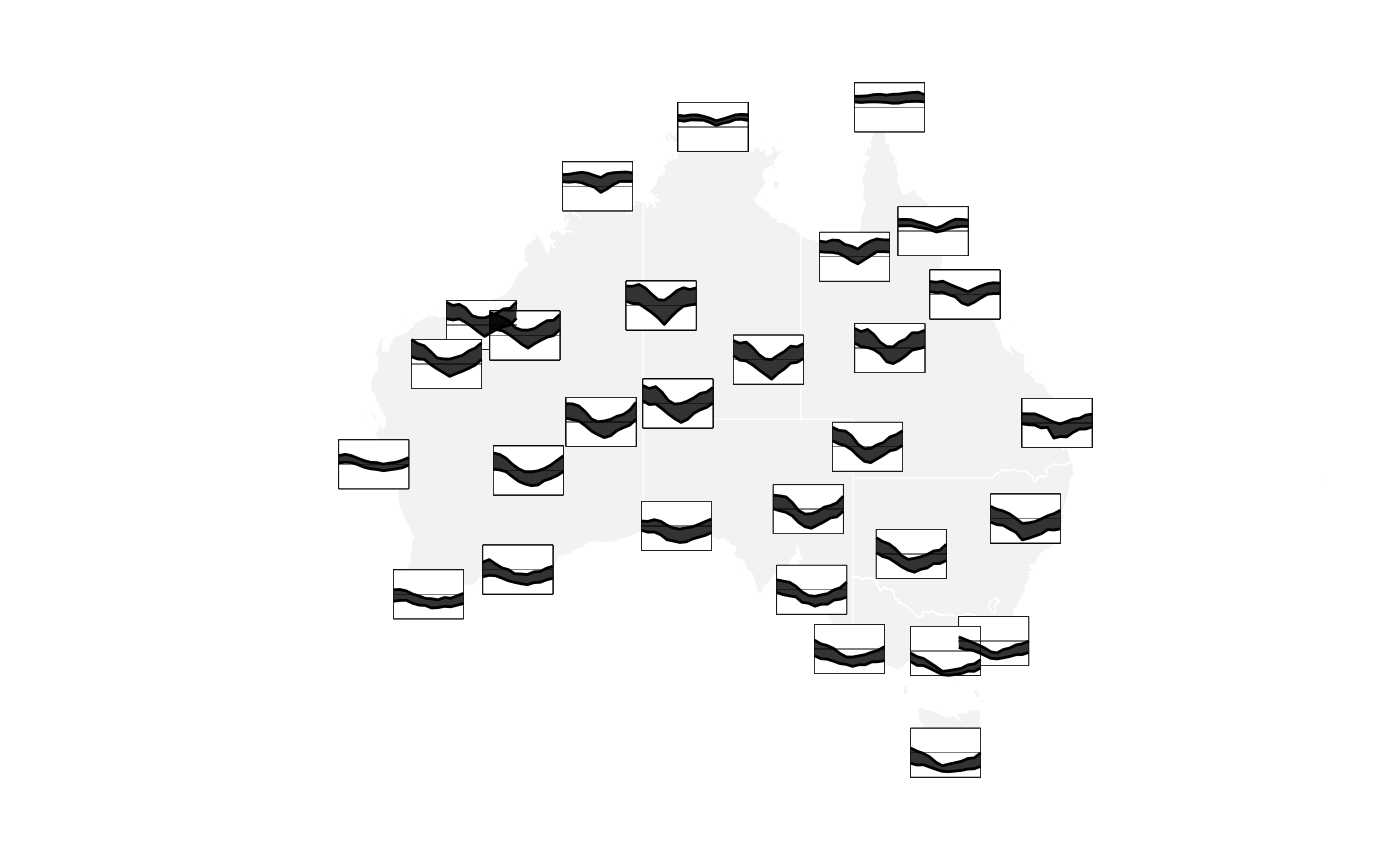This function creates a ribbon geometry designed to display glyphs based on the combination of `x_major` and `y_major`. For each `x_minor` value, `geom_glyph_ribbon()` displays a y interval defined by `ymin_minor` and `ymax_minor`.
Usage
geom_glyph_ribbon(
mapping = NULL,
data = NULL,
show.legend = NA,
stat = "identity",
position = "identity",
x_major = NULL,
y_major = NULL,
x_minor = NULL,
ymin_minor = NULL,
ymax_minor = NULL,
height = "default",
width = "default",
x_scale = identity,
y_scale = identity,
global_rescale = TRUE,
inherit.aes = TRUE,
...
)Arguments
- mapping
Set of aesthetic mappings created by
aes(). If specified andinherit.aes = TRUE(the default), it is combined with the default mapping at the top level of the plot. You must supplymappingif there is no plot mapping.- data
The data to be displayed in this layer. There are three options:
If
NULL, the default, the data is inherited from the plot data as specified in the call toggplot().A
data.frame, or other object, will override the plot data. All objects will be fortified to produce a data frame. Seefortify()for which variables will be created.A
functionwill be called with a single argument, the plot data. The return value must be adata.frame, and will be used as the layer data. Afunctioncan be created from aformula(e.g.~ head(.x, 10)).- show.legend
logical. Should this layer be included in the legends?
NA, the default, includes if any aesthetics are mapped.FALSEnever includes, andTRUEalways includes. It can also be a named logical vector to finely select the aesthetics to display.- stat
The statistical transformation to use on the data for this layer. When using a
geom_*()function to construct a layer, thestatargument can be used the override the default coupling between geoms and stats. Thestatargument accepts the following:A
Statggproto subclass, for exampleStatCount.A string naming the stat. To give the stat as a string, strip the function name of the
stat_prefix. For example, to usestat_count(), give the stat as"count".For more information and other ways to specify the stat, see the layer stat documentation.
- position
A position adjustment to use on the data for this layer. This can be used in various ways, including to prevent overplotting and improving the display. The
positionargument accepts the following:The result of calling a position function, such as
position_jitter(). This method allows for passing extra arguments to the position.A string naming the position adjustment. To give the position as a string, strip the function name of the
position_prefix. For example, to useposition_jitter(), give the position as"jitter".For more information and other ways to specify the position, see the layer position documentation.
- x_major, y_major, x_minor, ymin_minor, ymax_minor
Each combination of `x_major` and `y_major` forms a unique grid cell. `ymin_minor` and `ymax_minor` define the lower and upper bounds of the geom_ribbon.
- height
The height of each glyph. The `default` is calculated using the ratio (1:1.618) relative to the `width`, to maintain a consistent aspect ratio.
- width
The width of each glyph. The `default` is set to the smallest distance between two consecutive coordinates, converted from meters to degrees of latitude using the Haversine method.
- x_scale, y_scale
The scaling function applied to each set of minor values within a grid cell. Defaults to `identity`.
- global_rescale
A setting that determines whether to perform rescaling globally or on individual glyphs.
- inherit.aes
If
FALSE, overrides the default aesthetics, rather than combining with them. This is most useful for helper functions that define both data and aesthetics and shouldn't inherit behaviour from the default plot specification, e.g.borders().- ...
Additional arguments passed on to function.
Examples
library(ggplot2)
#> Warning: package ‘ggplot2’ was built under R version 4.2.3
# Basic glyph map with base map and custom theme
aus_temp |>
ggplot(aes(x_major = long, y_major = lat,
x_minor = month, ymin_minor = tmin, ymax_minor = tmax)) +
geom_sf(data = ozmaps::abs_ste, fill = "grey95",
color = "white",inherit.aes = FALSE) +
geom_glyph_ribbon() +
ggthemes::theme_map()
 # Adjust width and height of the glyph
aus_temp |>
ggplot(aes(x_major = long, y_major = lat,
x_minor = month, ymin_minor = tmin, ymax_minor = tmax)) +
geom_sf(data = ozmaps::abs_ste, fill = "grey95",
color = "white",inherit.aes = FALSE) +
geom_glyph_ribbon(width = rel(4.5), height = rel(3)) +
ggthemes::theme_map()
# Adjust width and height of the glyph
aus_temp |>
ggplot(aes(x_major = long, y_major = lat,
x_minor = month, ymin_minor = tmin, ymax_minor = tmax)) +
geom_sf(data = ozmaps::abs_ste, fill = "grey95",
color = "white",inherit.aes = FALSE) +
geom_glyph_ribbon(width = rel(4.5), height = rel(3)) +
ggthemes::theme_map()
 # Extend glyph map with reference box and line
aus_temp |>
ggplot(aes(x_major = long, y_major = lat,
x_minor = month, ymin_minor = tmin, ymax_minor = tmax)) +
geom_sf(data = ozmaps::abs_ste, fill = "grey95",
color = "white",inherit.aes = FALSE) +
add_glyph_boxes() +
add_ref_lines() +
geom_glyph_ribbon() +
ggthemes::theme_map()
# Extend glyph map with reference box and line
aus_temp |>
ggplot(aes(x_major = long, y_major = lat,
x_minor = month, ymin_minor = tmin, ymax_minor = tmax)) +
geom_sf(data = ozmaps::abs_ste, fill = "grey95",
color = "white",inherit.aes = FALSE) +
add_glyph_boxes() +
add_ref_lines() +
geom_glyph_ribbon() +
ggthemes::theme_map()
